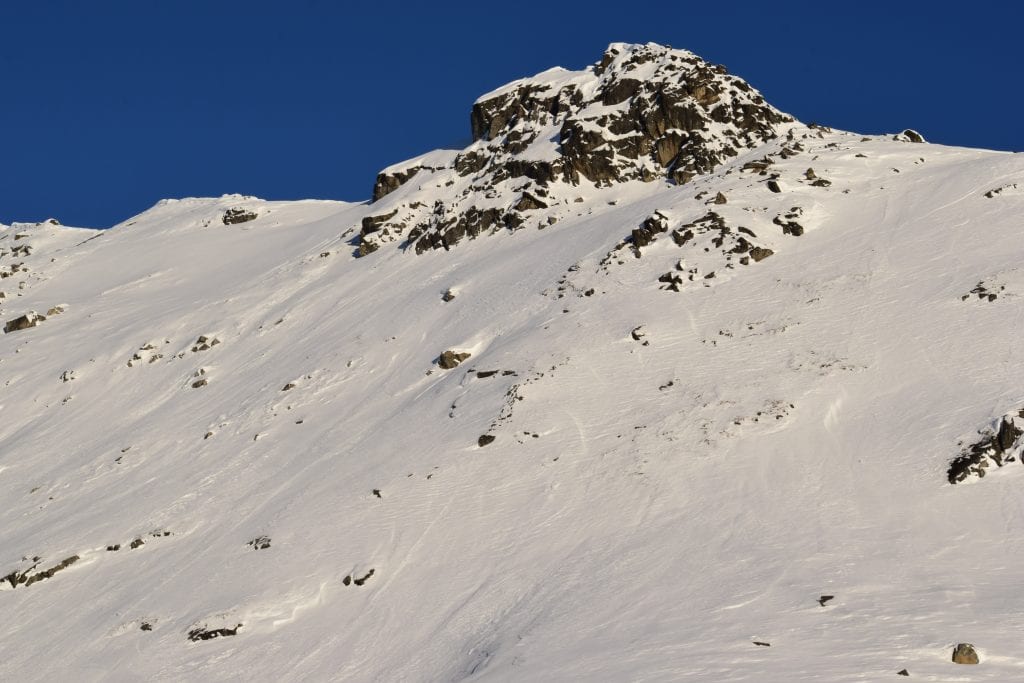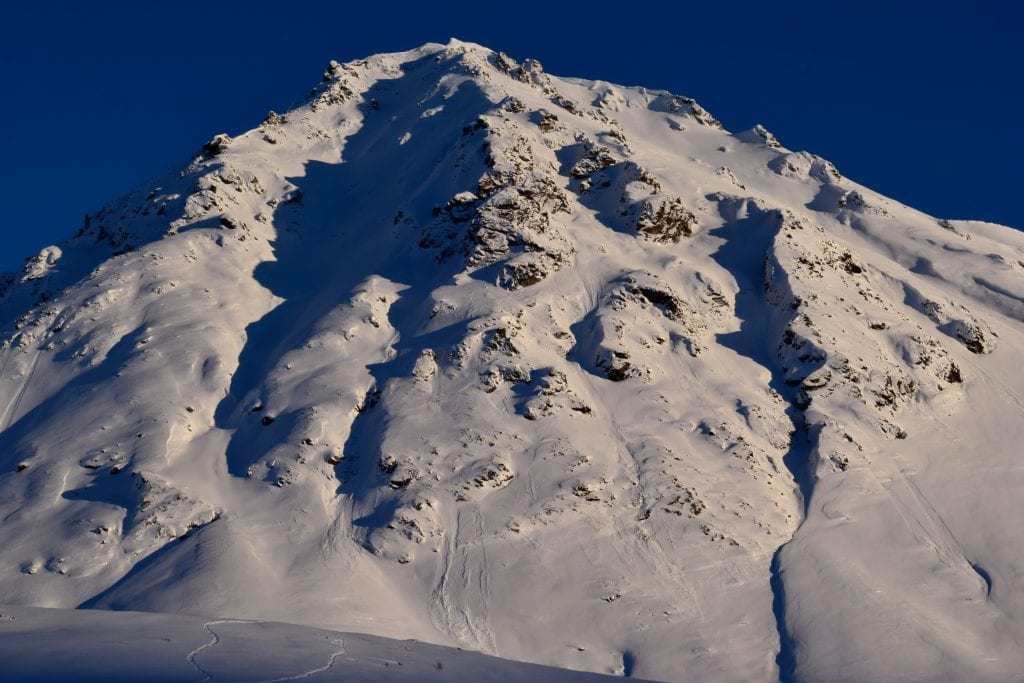

Hatcher Pass
|
|
This information is a Conditions Update. Danger ratings are only issued with avalanches advisories. The next avalanche advisory is scheduled for Saturday January 12, 2019.
Previous avalanche advisories HERE
MIDWEEK SNOW AND AVALANCHE CONDITIONS SUMMARY
While the likelihood of triggering a slab avalanche is decreasing slowly with time, there is still a possibility of triggering an avalanche large enough to bury, injure, or kill a person. Evaluate snow and terrain carefully, identifying features of concern.
Hatcher Pass has had cold temperatures, clear skies, and calm winds this week. The last human-triggered slab avalanche was during the New Year’s storm wind event on 12/30/18, but small loose dry avalanches or sluffs have been observed throughout the week on steep slopes. The last natural slab avalanches occurred shortly after the New Year’s storm.
Current surface conditions are making for excellent skiing and riding in areas like Independence Mine Bowl where the latest round of snow from the New Year’s storm fell under calm winds. However, windward (Easterly to Southerly) aspects are very shallow in places, making it difficult to ski or ride without hitting rocks. In areas like Peak 4068, Government Peak, and Arkose Ridge the snow appears noticeably wind-affected and conditions are likely not as nice for skiing and riding.
This report is a mid-week conditions update, so please be sure to check hpavalanche.org for advisories on Saturdays and follow the HPAC Facebook for updates. Help us keep tabs on the Hatcher Pass area! If you see any avalanche activity send us an observation HERE. Thank you to everyone who has already submitted observations this season – you can see those HERE!

Windward aspects are very shallow in places, making it difficult to ski or ride without hitting rocks.

Buy tickets for the event here. We will have the award-winning band Tanana Rafters.
Unable to make it to our fundraiser? Consider donating to keep avalanche information like this coming from HPAC!
| |
|
|
|
|
|
| Travel Advice | Generally safe avalanche conditions. Watch for unstable snow on isolated terrain features. | Heightened avalanche conditions on specific terrain features. Evaluate snow and terrain carefully; identify features of concern. | Dangerous avalanche conditions. Careful snowpack evaluation, cautious route-finding, and conservative decision-making essential. | Very dangerous avalanche conditions. Travel in avalanche terrain not recommended. | Extraordinarily dangerous avalanche conditions. Avoid all avalanche terrain. |
| Likelihood of Avalanches | Natural and human-triggered avalanches unlikely. | Natural avalanches unlikely; human-triggered avalanches possible. | Natural avalanches possible; human-triggered avalanches likely. | Natural avalanches likely; human-triggered avalanches very likely. | Natural and human-triggered avalanches certain. |
| Avalanche Size and Distribution | Small avalanches in isolated areas or extreme terrain. | Small avalanches in specific areas; or large avalanches in isolated areas. | Small avalanches in many areas; or large avalanches in specific areas; or very large avalanches in isolated areas. | Large avalanches in many areas; or very large avalanches in specific areas. | Very large avalanches in many areas. |
Numerous dry loose avalanches have been observed on all aspects above 3000′ on steep slopes.
Persistent weak layers in the snowpack still exist, but are slowly stabilizing over time. While the likelihood of triggering a slab avalanche is decreasing, the possibility is still present, and the consequences could be high. This avalanche problem will be difficult to predict, but the likelihood of triggering an avalanche will be greater above 3000’, on all aspects, on slopes 35° and steeper.
The snowpack depth is highly variable, from 1-5 feet deep, with the deepest snowpack at upper elevations, on West to North aspects, due to wind loading through the season. Triggering an avalanche on these leeward aspects will be more consequential than windward, shallower aspects due to the amount of snow involved.
There may be no warning signs like shooting cracks, whumphing, or collapsing before an avalanche is triggered. One of the biggest things we can do to increase our margin of safety is to choose slopes with gentle fanning run-outs and avoid terrain traps. Unsupported slopes in steep, shallow, rocky terrain will be more likely to harbor the avalanche problem.
Keep in mind that the poor structure of our snowpack won’t be going away anytime soon, and any new rapid load may re-activate weak layers in our snowpack.

Snow pit on Microdot’s south aspect showing a dense slab sitting on several weak layers of snow.
While the New Year’s storm snow has settled, there is still 4″-12′” of low density snow. It will be possible to trigger loose dry avalanches on slopes 40º and steeper above 3000 ft. While these avalanches may not be large enough to bury you, they may knock you off of your feet in steep terrain, carry you in to terrain traps such as rocks and cliffs, or possibly bury you if caught in a terrain trap such as a creek, ravine, gully or depression.

Weather History
This week’s weather at 3550′:
Temperatures averaged 10°F, with a low of 1°F and a high of 16°F.
There was 1/3rd” of new snow overnight.
This week’s weather at 4500′:
Temperatures averaged 7°F, with a low of 3°F and a high of 11°F.
Winds averaged variable 3 mph, max 9 mph. Gusts averaged variable 6 mph, max gust 13 mph.
Forecast Weather
Stay tuned to the NOAA point forecast for an updated weather forecast each day. The best way to see if it’s snowing in Hatcher Pass is to look at the webcam snow stake HERE and the Independence Mine SNOTEL site HERE
State Parks Snow Report and Motorized Access information can be found here.